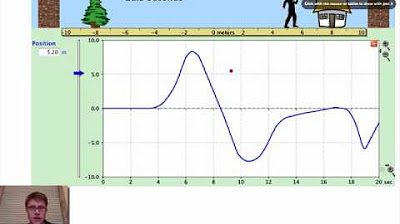G Forces
TLDRIn this educational video, Mr. Thompson explains the concept of g-forces in an intuitive manner, illustrating how they are experienced in various situations such as driving, rollercoasters, and space travel. He clarifies that g-forces are not a force but a measure of acceleration relative to gravity, felt as weight changes due to acceleration or deceleration. Through examples like astronauts in space and divers, he demonstrates states of weightlessness and the mathematical calculations behind g-forces during acceleration, deceleration, and circular motion.
Takeaways
- 🧭 G-forces are a measure of the apparent weight a person feels, influenced by both gravity and acceleration.
- 🌍 Standing on Earth, we experience 1g due to the force of gravity, which is the standard weight we feel at rest.
- 🚀 In a rocket ship accelerating in space, the absence of gravity and the acceleration cause a sensation of increased weight, measured in multiples of g.
- 🎢 On a roller coaster, at the bottom of a dip, passengers feel heavier due to the combination of gravity and centripetal acceleration.
- 🌌 Astronauts in space, far from Earth's gravity, experience weightlessness, or 0g, as there is no force of gravity acting on them.
- 🏗️ In a high-diving scenario, the diver feels weightless during the free fall, as the acceleration due to gravity is balanced by the inertial force.
- 🛠️ G-force is not a force itself but is measured in units of acceleration, with 1g being equivalent to the acceleration due to gravity (9.8 m/s^2).
- 🔄 Newton's first law of motion explains inertia, the resistance of an object to changes in its state of motion, which is felt as an inertial force during acceleration.
- 🛤️ In a lift accelerating upwards, passengers feel heavier due to the inertial force resisting the upward acceleration, in addition to the force of gravity.
- 🎢 At the top of a roller coaster hill, passengers feel lighter because the inertial force resisting the downward acceleration is less than the force of gravity.
- 🔢 The total g-force experienced can be calculated by considering both the gravitational component and the inertial component due to acceleration.
Q & A
What is a g-force?
-A g-force is a measure of the force experienced by an individual due to acceleration or gravity. It's typically felt as an increase or decrease in weight, and it's measured in multiples of the acceleration due to gravity on Earth, which is approximately 9.8 m/s^2.
How do racing cars and fighter pilots experience g-forces?
-Racing cars and fighter pilots experience g-forces due to rapid acceleration or deceleration. The driver in a racing car feels a g-force pushing them back into the seat when accelerating quickly. Similarly, a fighter pilot may experience high g-forces when performing tight maneuvers or rapid changes in speed.
What does it mean to feel weightless?
-Feeling weightless means experiencing zero g-forces, which typically occurs when there is no gravity acting on a body, such as in space, or when an object is in free fall.
Why do we feel heavier at the bottom of a rollercoaster dip?
-At the bottom of a rollercoaster dip, the centripetal acceleration is directed upwards, causing an inertial force that adds to the force of gravity. This results in a sensation of increased weight, or more than 1g.
What is the relationship between g-force and acceleration?
-G-force is directly related to acceleration. It is the measure of the acceleration experienced by an object in multiples of the Earth's gravitational acceleration (1g). The greater the acceleration, the higher the g-force felt.
How is g-force calculated when considering both gravity and acceleration?
-G-force is calculated by considering the gravitational force (1g if on Earth) and the inertial force resulting from acceleration. The total g-force is the sum of these two components, where the inertial force is the resistance to acceleration felt by the body.
Why do we feel lighter at the top of a rollercoaster hill?
-At the top of a rollercoaster hill, the centripetal acceleration is directed downwards, which means the inertial force is directed upwards, opposing the force of gravity. This results in a sensation of reduced weight or less than 1g.
What is the significance of the term 'inertial force' in the context of g-forces?
-Inertial force refers to the sensation of a force acting on a body due to its resistance to acceleration, as described by Newton's first law of motion. It's not an actual force but rather the body's inertia resisting changes in motion, which is perceived as a g-force.
How does a rocket launch affect the g-forces experienced by an astronaut?
-During a rocket launch, astronauts experience high g-forces due to the rapid acceleration of the rocket. The g-forces are a combination of the gravitational force and the inertial force resisting the upward acceleration, which can result in a sensation of increased weight.
What happens to the g-forces when a roller coaster goes through a loop?
-When a roller coaster goes through a loop, the g-forces experienced by the passengers depend on the centripetal acceleration and the speed of the roller coaster. If the speed is sufficient, passengers may feel a positive g-force pushing them into their seats at the top of the loop. If the speed is too low, they may experience negative g-forces, feeling as if they are being pulled out of their seats.
Outlines
🚀 Introduction to G-Forces
Mr. Thompson introduces the concept of g-forces, explaining that they are experienced in situations involving rapid acceleration or deceleration, such as in racing cars or by fighter pilots. He provides examples like Jeremy Clarkson in a car and clarifies that g-forces result from both gravity and acceleration. The video aims to offer a simple and intuitive explanation of how g-forces are calculated in various scenarios.
🌌 G-Forces in Zero Gravity
The script discusses the experience of g-forces in zero gravity environments, such as space or during the free fall of a high diver, where individuals feel weightless, equating to zero g's. It contrasts this with the sensation of 1g experienced on Earth when standing still or moving at a constant speed, unaffected by additional acceleration.
🔽 Experiencing G-Forces in Different Situations
The video script explores various situations where g-forces are experienced, such as at the bottom of a rollercoaster dip, in a rapidly accelerating elevator, and during a rocket launch. It explains that in these scenarios, individuals feel heavier due to the combination of gravity and the inertial force resulting from acceleration.
⏫ The Physics of G-Forces
The script delves into the physics behind g-forces, distinguishing them from actual forces and relating them to acceleration. It explains that g-forces are measured in multiples of the acceleration due to gravity (9.8 m/s^2) and are influenced by both gravity and inertial forces. The concept of inertia is introduced, illustrating how it resists changes in motion and contributes to the sensation of g-forces.
📉 G-Forces Calculations in Various Scenarios
The script provides mathematical examples to calculate g-forces in different situations, such as standing on the ground, being in space, inside a rocket ship, and in an accelerating elevator. It demonstrates how to combine the effects of gravity and inertial forces to determine the total g-force experienced.
🎢 G-Forces in Roller Coaster Dynamics
The video script examines g-forces experienced on a roller coaster, particularly at the bottom of a dip and at the top of a crest, as well as in a loop. It explains how the centripetal acceleration during circular motion contributes to the sensation of being heavier or lighter than usual, and how this can result in negative g-forces, potentially causing riders to feel weightless or even lifted from their seats.
🤸♂️ Conclusion on G-Forces and Weightlessness
In the final part of the script, Mr. Thompson revisits the concept of weightlessness, using the example of a diver in free fall to illustrate mathematically how g-forces can sum to zero. He concludes by summarizing the key points discussed in the video and thanks the viewers for their patience.
Mindmap
Keywords
💡g-force
💡acceleration
💡gravity
💡weightlessness
💡inertial force
💡centripetal acceleration
💡Newton's first law
💡multiples of gravity
💡deceleration
💡roller coaster
Highlights
G-force is defined as the perceived weight experienced during acceleration or gravity.
G-forces are commonly discussed in contexts like racing cars and fighter pilots' maneuvers.
An astronaut in space far from Earth experiences weightlessness, or zero G's.
A person standing on Earth's surface feels 1g due to the force of gravity.
G-forces can be greater than 1g during rapid acceleration or in a rollercoaster at the bottom of a dip.
In a rocket ship at launch, individuals feel more than 1g due to the combined effects of gravity and acceleration.
G-forces can also be less than 1g, making a person feel lighter, such as at the top of a rollercoaster hill.
G-force is measured in multiples of the acceleration due to gravity, which is 9.8 m/s^2.
G-forces consist of two components: gravity and the inertial force experienced during acceleration.
Inertia is the resistance of an object to changes in its state of motion, which contributes to the sensation of g-force.
The sensation of g-force is actually the feeling of inertia resisting acceleration.
Mathematically, g-force is calculated by considering both gravitational force and inertial force.
An astronaut in space with no gravity and no acceleration experiences zero G's.
In a rocketship accelerating in space, the g-force is calculated based on the acceleration rate relative to gravity.
During upward acceleration in a lift, the total g-force is the sum of gravitational force and the inertial force resisting acceleration.
At the top of a rollercoaster hill, the g-force can be less than 1g, causing a sensation of lightness.
During a rollercoaster loop, the g-force can be positive or negative depending on the direction of centripetal acceleration.
In a diving scenario, the diver experiences zero G's due to the balance of gravity and inertial forces.
Transcripts
5.0 / 5 (0 votes)
Thanks for rating:





